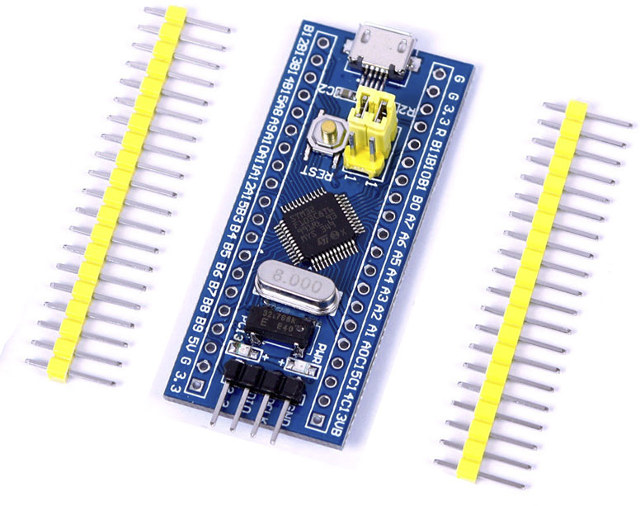I’m amazed that if your budget for a board was just $5 for one MCU board, you now have so many options for your electronics projects: ESP8266 boards, a few STM8 boards, One Dollar Board project, and many more… Other options are “BluePill” or “RedPill” boards based on STM32 or GD32 32-bit ARM Cortex M3 micro-controllers that go for about $2 shipped, and can be programmed with the Arduino IDE thanks to STM32Duino project.
BluePill board specifications:
- MCU – STMicro STM32F103C8T6 ARM Cortex-M3 MCU @ 72 MHz with 64KB flash memory, 20KB SRAM.
- USB – 1x micro USB port for power and programming
- Debugging – 4x pin SWD header or micro USB port
- Expansion – 2x 20-pin with power signals, I2C, SPI, GPIOs, ADC inputs, etc…
- Misc – Reset button, two jumpers (for boot mode), power and user LEDs.
- Power – 5V via USB, 2.0-3.6V power via 3.3V pin on SWD header.
- Dimensions – 5.3cm x 2.2cm.
I specifically wrote about “BluePill” board instead of “RedPill”, because one thread on STM32duino forums mention the former is a bit better. You can find documentation on Piffa.net wiki (Italian only) and STM32duino wiki. Most instructions use a USB to serial (TTL) board to program connected to PA9 and PA10 pins to program the board, but I understand that USB programming if possible by replacing the 10kΩ pull up resistor on PA12 (USB D+) by a 1.5kΩ resistor.
The video below shows how to use the STM32 board with a serial debug board, and the Arduino IDE.
One interesting fact about the $2 price tag for the board (remember it also includes shipping) is that STM32F103C8T6 MCU itself is supposed to sell for $2.056 in 10k quantities, until you are looking for actual pricing in China, where it is sold for less than one dollar (6 RMB).
Beside Aliexpress, you can also find the board on eBay. Few sellers call it BluePill, and instead they are often called “STM32 Minimum System Development Board”, but a search for “STM32F103C8T6″ on your favorite resellers should also list the board.
Thank you Zoobab!

Jean-Luc started CNX Software in 2010 as a part-time endeavor, before quitting his job as a software engineering manager, and starting to write daily news, and reviews full time later in 2011.
Support CNX Software! Donate via cryptocurrencies, become a Patron on Patreon, or purchase goods on Amazon or Aliexpress





